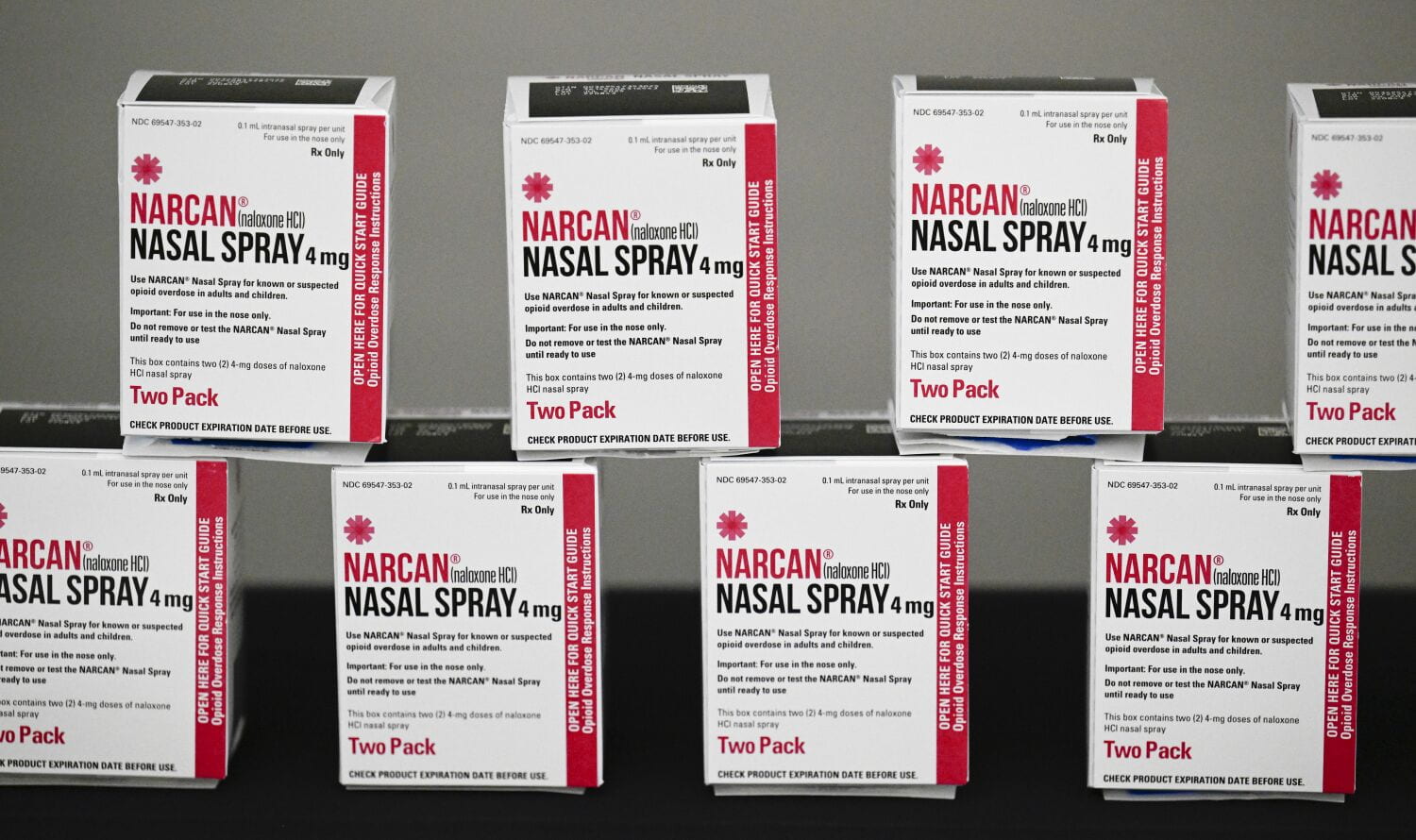
Narcan is on display at a county news conference held to announce the free distribution of Harm Reduction Kits on Jan. 23, 2023, in San Diego. Credit: Denis Poroy via TNS
The Ohio State community can soon have better access to overdose reversal medication from a program by Gov. Mike DeWine that experts say will help save lives and spread awareness on overdose prevention.
The RecoveryOhio initiative, a measure commissioned by DeWine to combat drug addiction and overdoses, is working in partnership with the Ohio Department of Higher Education and the Ohio Department of Health to offer up to five free emergency access cabinets of naloxone — the medication that helps reverse overdoses caused by opioids by blocking the drug’s effect and restoring breathing — to public colleges and universities across the state, according to a Feb. 21 release.
Naloxone cabinets are designed to hold all “overdose emergency delivery mechanisms” that are on the market using a mounting system. The department stated the naloxone cabinets are “a voluntary program and emergency access cabinets are available in limited quantities on a first-come, first-served basis.” The department recommends each institution create a policy for how often each box is reviewed and restocked, according to the release.
Andrea Boxill, administrator at Columbus Public Health, said she thinks this initiative is beneficial.
“I think [the cabinet]’s innovative. It’s forward-thinking. And it is a best practice to keep young people safe,” Boxill said.
Boxill said naloxone is “critical, especially in the state of Ohio,” due to the high rate of overdose-related deaths statewide and in Franklin County.
The Centers for Disease Control and Prevention reported in 2020, there were over 5,000 drug-overdose related deaths in Ohio.
According to the Franklin County Coroner, over 800 people die each year as a result of overdoses in Franklin County, with people aged 15 to 34 accounting for a quarter of all overdoses.
The program comes three years after DeWine signed House Bill 341 in 2020, which expanded access to naloxone through many means, including emergency access cabinets, according to the release.
Shae Dalrymple, communications director and naloxone distributor for Harm Reduction Ohio, said these cabinets are expected to bring more accessibility and awareness of naloxone to students.
Boxill said normalizing naloxone will help reduce the stigma associated with drug use and addiction.
“The more present you see advertising [for naloxone], the more it becomes normal. We want to normalize it because medication exists. We want to normalize because it takes away the stigma,” Boxill said.
In the case of students, many overdoses occur because synthetic opioids are combined and laced with other types of drugs, Dalrymple said.
“With young people specifically, it’s that they don’t know what they’re getting. Fentanyl is in most of the drug supply,” Dalrymple said.
According to the CDC, drug overdoses caused nearly 110,000 deaths nationally in 2021, with more than half coming from synthetic opioids, like fentanyl, that can be prevented with the naloxone medication.
Three Ohio State students were hospitalized after an off-campus overdose in May 2022. The overdoses caused two fatalities. At that time, fake Adderall pills laced with fentanyl were found around Ohio State’s Columbus campus which caused an increase in overdoses and hospitalizations, according to CPH.
According to a 2018 Ohio State study, about 16 percent of students admitted to misusing stimulants — drugs that speed up brain activity. These drugs can cause side effects that can impair cognitive abilities if mixed with alcohol or not prescribed.
Dalrymple said the cabinets are a step in the right direction, but people should still be careful because it can take more than two doses of naloxone to reverse an overdose, and “you can only fit so many kits into one of those boxes.”
“It’s important, and it’s definitely good for making people more aware of [naloxone]’s availability, but I definitely recommend that just everybody carry it,” Dalrymple said.
Outside this new initiative from the state government, Ohio State currently offers its own form of naloxone access and educational training about the medication and how to use it.
The Wilce Student Health Center makes naloxone available to all students at no cost for those with or without insurance. The Student Wellness Center offers “Carry Naloxone. Save a Life” training, which teaches students how to spot the signs of an overdose, how to use naloxone and key harm reduction concepts as they relate to drug use.
Ohio State also implemented a drug and alcohol misuse course for first-year students in July 2022.
Dalrymple said naloxone should be widely available in public spaces — similar to automated external defibrillators in preparation for a cardiac event — and carried by individuals in the event of an opioid overdose, as it becomes a more common issue.
University spokesperson Chris Booker said in an email Ohio State is looking into the program.
“Ohio State commends Governor DeWine on his leadership and support of this voluntary program to provide emergency naloxone access cabinets for installation on public college and university campuses around the state,” Booker said. “The university is examining the proposal at this time.”


